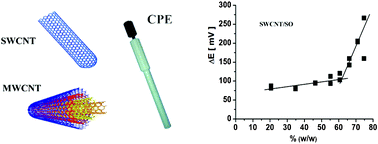The ohmic resistance effect for characterisation of carbon nanotube paste electrodes (CNTPEs)†
Abstract
In this study,

- This article is part of the themed collection: Future Electroanalytical Developments
* Corresponding authors
a University of Pardubice, Faculty of Chemical Technology, Department of Analytical Chemistry, Studentská 573, Pardubice, Czech Republic
b
J. Heyrovský Institute of Physical Chemistry ASCR, v.v.i., Dolejškova, Prague 8, Czech Republic
E-mail:
jiri.ludvik@jh-inst.cas.cz
Tel: +420-266 053 217
In this study,

 Please wait while we load your content...
Something went wrong. Try again?
Please wait while we load your content...
Something went wrong. Try again?
T. Mikysek, M. Stočes, I. Švancara and J. Ludvík, RSC Adv., 2012, 2, 3684 DOI: 10.1039/C2RA20202F
To request permission to reproduce material from this article, please go to the Copyright Clearance Center request page.
If you are an author contributing to an RSC publication, you do not need to request permission provided correct acknowledgement is given.
If you are the author of this article, you do not need to request permission to reproduce figures and diagrams provided correct acknowledgement is given. If you want to reproduce the whole article in a third-party publication (excluding your thesis/dissertation for which permission is not required) please go to the Copyright Clearance Center request page.
Read more about how to correctly acknowledge RSC content.
 Fetching data from CrossRef.
Fetching data from CrossRef.
This may take some time to load.
Loading related content
